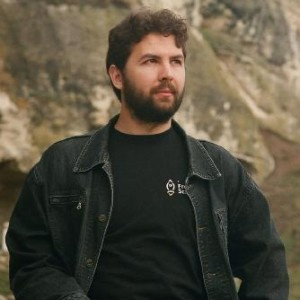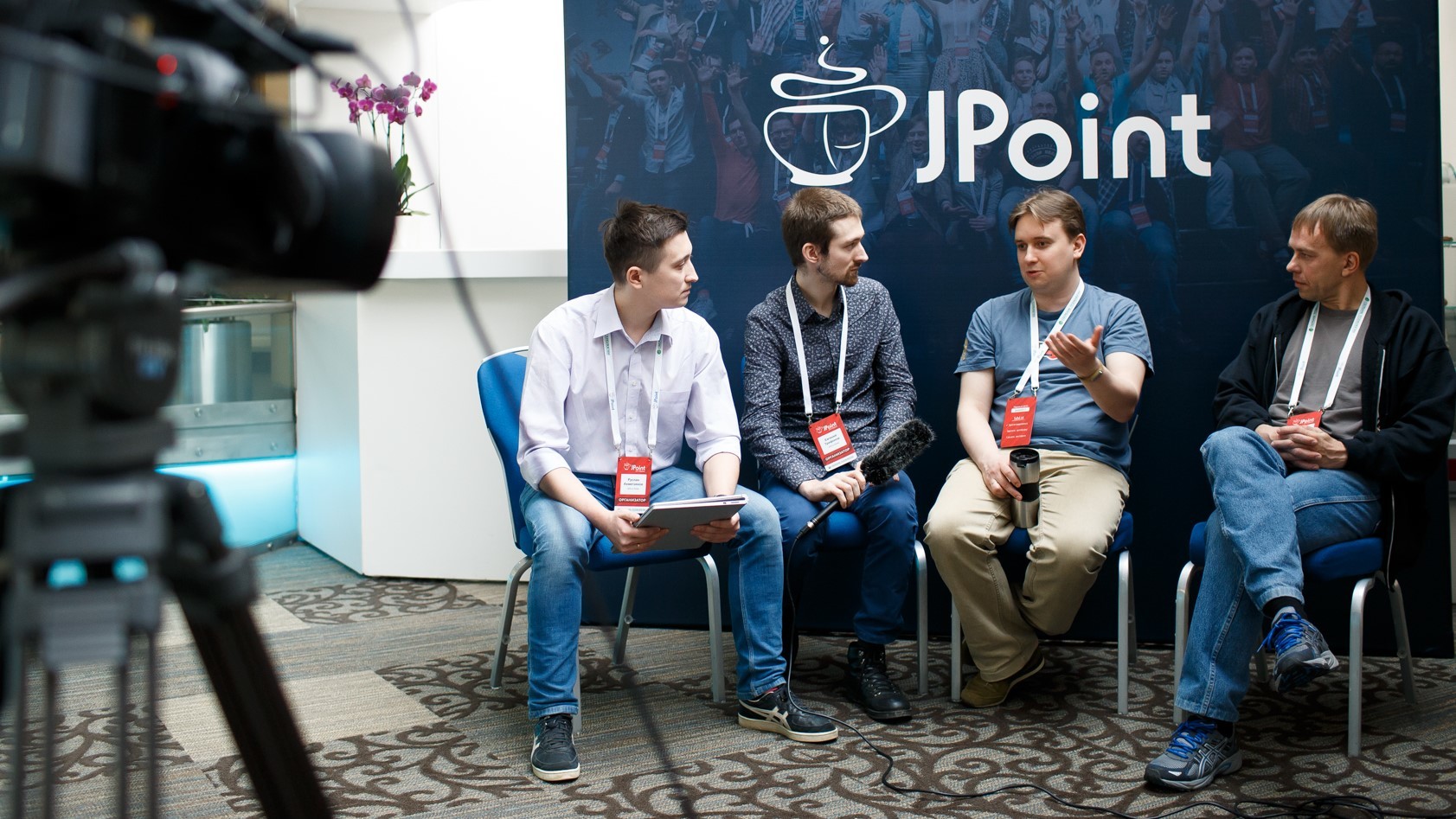Open broadcast from the main conference hall of HolyJS 2017 Piter: Douglas Crockford, Lea Verou and someone else
We continue to share open broadcasts for those who want to receive the Sabbath stream of power! Earlier we already opened the broadcasts from the conferences DotNext 2017 Piter , Mobius 2017 Piter and JPoint 2017 (now access to it is closed). This time, the source of strength will be fed by JavaScript developers.
June 3, 2017 at 10 am (Moscow time) will begin a free online broadcast from the main hall of HolyJS 2017 Piter!

')
The first track (held in the main hall) is the largest and most popular among our participants. On the second day of the conference in the first track will perform:
In addition, from 10 am and in between presentations you can watch live interviews with speakers and conference participants. Do not switch!
Link to the broadcast and detailed program - under the cut.
 10: 30-11: 30 Alexey Zolotykh - ES2017 vs Typescript vs Dart. Compare without emotion
10: 30-11: 30 Alexey Zolotykh - ES2017 vs Typescript vs Dart. Compare without emotion
Developers often have the difficult task of choosing a programming language to develop the client side of the application. As a rule: the choice is between three whales: JavaScript, TypeScript and Dart. Easy battle of technology without deep immersion. Alexey knows what he is talking about; in 10 years of JS development, he managed to try a lot.
 12: 00-13: 00 Douglas Crockford - Goto There and Back Again
12: 00-13: 00 Douglas Crockford - Goto There and Back Again
This (the second in a row) report by Douglas Crockford at the HolyJS 2017 Piter conference will be presented in the style of “two steps forward, three steps back, or why you need to know the way of technology development”. We will deal with contradictions in language design, starting with Dijkstra's letter to the editor.
And yes, as sincerely loving JS and finding good sides in him, Douglas will not stand on ceremony. Prepare for the fact that the lessons of strength and dance lessons will be with Douglas in full.
 13: 30-14: 30 Anjana Vakil - Functional Programming in JS: What? Why? How?
13: 30-14: 30 Anjana Vakil - Functional Programming in JS: What? Why? How?
Anjana dedicated her report to functional JS programming using basic JS features and some popular FP libraries, such as Mori and Ramda. In her spare time, Anjana has already gone from philosophy to teaching English and from applied linguistics to software development. Therefore, she will be able to intelligibly answer questions about how a functional code looks and how it is better than others; how to start writing in the style of functional programming; whence such a rush, and most importantly - why?
 15: 15-16: 15 Alexey Ivanov - The internal structure of the webpack bundle
15: 15-16: 15 Alexey Ivanov - The internal structure of the webpack bundle
Webpack has become the de facto standard for building large JS applications. Almost everything uses it, but, as a rule, as a black box: if we put the files here and write such and such lines into the config, then the output will automatically result in a bundle. Experience with projects for eBay, Yandex and Communigate made it possible to understand how the bundle looks from the inside, how different settings affect it, why some settings can lead to unexpected side effects, and how to debug and optimize all of this. This will be shared by Alexey in his report.
 16: 45-17: 45 Vladimir Grinenko - Dependencies in the component web made correctly
16: 45-17: 45 Vladimir Grinenko - Dependencies in the component web made correctly
Modular systems imply that all modules will communicate with each other as a whole, while the module is only one component, all components are dependent on each other, and they must be expressed.
Dependencies between components pull a lot of problems: hardcoding, refactoring complexity and other troubles.
In his report, Vladimir Grinenko, being the head of the group of common interface components in the Simferopol office of Yandex, will show how to get rid of many, if not all, troubles. The report will explain how to apply the new approach using the example of assembly on Gulp and Webpack. And also about the package, which not only allows you to collect projects on React in this way, but also provides multiple inheritance for React components.
 18: 15-19: 15 Lea Verou - JS UX: Writing code for humans
18: 15-19: 15 Lea Verou - JS UX: Writing code for humans
Lea Verou is the author of the book “CSS Secrets” and one of the CSS Working Group experts. While someone divides people into “developers, techies,” and “humanities designers,” Leah is known for her love for both code and design, which she put into practice in several open source projects ( Prism , Dabblet and -prefix- free )
Not surprisingly, the JS UX: Writing code for humans keyhole will be associated with this intersection: Leah will tell you how using UX programming approaches can make your code better. In the end, the code that someone needs to read (including yourself in the future) is also a kind of UI!

The problem of many online broadcasts - empty breaks and coffee breaks. While the participants at the conference are drinking coffee and talking to the speakers, viewers of the broadcast are forced to look at the stubs and wait for the next report to begin.
We solved this problem in our own way - during the breaks events at the conference will be broadcast, as well as interviews with speakers. The interview will be conducted by Mikhail Poluboyarinov together with the phillennium - you will not be bored. Questions, if any should arise, can be asked in the Telegram-channel of the conference: t.me/holyjsconf
May the force be with you!
June 3, 2017 at 10 am (Moscow time) will begin a free online broadcast from the main hall of HolyJS 2017 Piter!

')
The first track (held in the main hall) is the largest and most popular among our participants. On the second day of the conference in the first track will perform:
- Alexey Zolotykh - ES2017 vs Typescript vs Dart. Compare without emotion
- Douglas Crockford - Goto There and Back Again
- Anjana Vakil - Functional Programming in JS: What? Why? How?
- Alexey Ivanov - Inside the webpack bundle
- Vladimir Grinenko - Dependencies in the component web made correctly
- Lea Verou - JS UX: Writing code for humans
In addition, from 10 am and in between presentations you can watch live interviews with speakers and conference participants. Do not switch!
Link to the broadcast and detailed program - under the cut.
Stream complete
Track program
 10: 30-11: 30 Alexey Zolotykh - ES2017 vs Typescript vs Dart. Compare without emotion
10: 30-11: 30 Alexey Zolotykh - ES2017 vs Typescript vs Dart. Compare without emotionDevelopers often have the difficult task of choosing a programming language to develop the client side of the application. As a rule: the choice is between three whales: JavaScript, TypeScript and Dart. Easy battle of technology without deep immersion. Alexey knows what he is talking about; in 10 years of JS development, he managed to try a lot.
 12: 00-13: 00 Douglas Crockford - Goto There and Back Again
12: 00-13: 00 Douglas Crockford - Goto There and Back AgainThis (the second in a row) report by Douglas Crockford at the HolyJS 2017 Piter conference will be presented in the style of “two steps forward, three steps back, or why you need to know the way of technology development”. We will deal with contradictions in language design, starting with Dijkstra's letter to the editor.
And yes, as sincerely loving JS and finding good sides in him, Douglas will not stand on ceremony. Prepare for the fact that the lessons of strength and dance lessons will be with Douglas in full.
 13: 30-14: 30 Anjana Vakil - Functional Programming in JS: What? Why? How?
13: 30-14: 30 Anjana Vakil - Functional Programming in JS: What? Why? How?Anjana dedicated her report to functional JS programming using basic JS features and some popular FP libraries, such as Mori and Ramda. In her spare time, Anjana has already gone from philosophy to teaching English and from applied linguistics to software development. Therefore, she will be able to intelligibly answer questions about how a functional code looks and how it is better than others; how to start writing in the style of functional programming; whence such a rush, and most importantly - why?
 15: 15-16: 15 Alexey Ivanov - The internal structure of the webpack bundle
15: 15-16: 15 Alexey Ivanov - The internal structure of the webpack bundleWebpack has become the de facto standard for building large JS applications. Almost everything uses it, but, as a rule, as a black box: if we put the files here and write such and such lines into the config, then the output will automatically result in a bundle. Experience with projects for eBay, Yandex and Communigate made it possible to understand how the bundle looks from the inside, how different settings affect it, why some settings can lead to unexpected side effects, and how to debug and optimize all of this. This will be shared by Alexey in his report.
 16: 45-17: 45 Vladimir Grinenko - Dependencies in the component web made correctly
16: 45-17: 45 Vladimir Grinenko - Dependencies in the component web made correctlyModular systems imply that all modules will communicate with each other as a whole, while the module is only one component, all components are dependent on each other, and they must be expressed.
Dependencies between components pull a lot of problems: hardcoding, refactoring complexity and other troubles.
In his report, Vladimir Grinenko, being the head of the group of common interface components in the Simferopol office of Yandex, will show how to get rid of many, if not all, troubles. The report will explain how to apply the new approach using the example of assembly on Gulp and Webpack. And also about the package, which not only allows you to collect projects on React in this way, but also provides multiple inheritance for React components.
 18: 15-19: 15 Lea Verou - JS UX: Writing code for humans
18: 15-19: 15 Lea Verou - JS UX: Writing code for humansLea Verou is the author of the book “CSS Secrets” and one of the CSS Working Group experts. While someone divides people into “developers, techies,” and “humanities designers,” Leah is known for her love for both code and design, which she put into practice in several open source projects ( Prism , Dabblet and -prefix- free )
Not surprisingly, the JS UX: Writing code for humans keyhole will be associated with this intersection: Leah will tell you how using UX programming approaches can make your code better. In the end, the code that someone needs to read (including yourself in the future) is also a kind of UI!
Broadcast in the breaks

The problem of many online broadcasts - empty breaks and coffee breaks. While the participants at the conference are drinking coffee and talking to the speakers, viewers of the broadcast are forced to look at the stubs and wait for the next report to begin.
We solved this problem in our own way - during the breaks events at the conference will be broadcast, as well as interviews with speakers. The interview will be conducted by Mikhail Poluboyarinov together with the phillennium - you will not be bored. Questions, if any should arise, can be asked in the Telegram-channel of the conference: t.me/holyjsconf
Restrictions
- Since the broadcast is free, it is provided on the principle of as is : we are sure that everything will be fine, but if that happens, do not blame me!
- There will be no video recordings. That is, they, of course, will be, but only for conference participants who have left feedback. And for all the others, we traditionally post them in 3-4 months.
- You cannot watch what happens in other halls. And there will be many interesting things . Next time register and watch everything without restrictions.
May the force be with you!
Source: https://habr.com/ru/post/329554/
All Articles